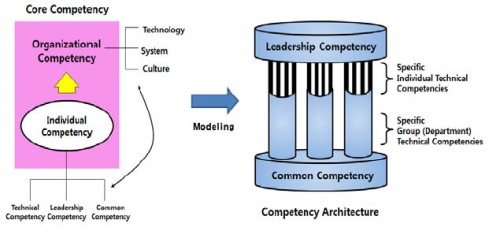Competency model
Contents
Definition
Competency model is A representation used to understand and communicate a selected aspect of competency
Summary
Competency model represents an aspect of competency that is relevant to the organisation. The purpose is to help the organisation to understand and communicate their competency related issues, e.g. their competency needs. Competency model typically identifies at least the core competencies of the organization and provides a link between these competencies and competency requirements for roles. Thus, competency model can be used as a tool to help an organisation to manage its competency. Competency model is often put in graphical form to enable communication of the essential features of competency needs.
Description
Contents of competency model
Competency model identifies the required competencies based on the strategy and objectives of the organisation. Typically the competency model has a future oriented view. Both individual and organisational competencies may be included competency model.
Competency model presents organization's most essential competency needs in a form that enables the organisation to take required actions. This typically includes linking competency needs to organization's strategy and objectives. Competency map is one possibility for presenting the competency needs in a graphical form.
Competency model identifies a hierarchy for the competency needed in the organisation. It describes core competency, collective competency and individual competency.
Typically, there is a competency model that is shared by the organization and it describes how different level roles should fulfill these, often very general, competency needs. When needed, more details models are created for different role families.
Competency model should describe links from competency needs to requirements for roles.
In addition to helping the organisation to align its competency related actions, a competency models can also be used as tool for individual development. They provide a framework for determining individual developments plans and career planning.
Benefits of developing and using competency model
Competency model identifies the core competencies of an organization based on its strategy. It provides a framework for illustrating competency needs both on organizational and individual level.
Competency model sets the bases for describing job descriptions and competency requirements for individual roles. It helps creating job descriptions which are behaviorally based and aligned with the overall strategy of the organisation. This type of job descriptions together with the competency model, provide a tool for career planning and creating development plans for critical roles.
Competency model also provides a tool for recruitment. It describes the needed competency to be used a s a criteria in the process.
Competency model can thus help the organization align their human resource related initiatives to their overall business strategy [1] and improve the involved decision making process.
Creating a competency model
Organizational competency mapping is one approach for creating a competency model that is linked to the overall objectives and needs of the organisation.
Competency framework for regulatory bodies
Fig 1 depicts a four-quadrant competency model developed for regulatory bodies. In this case, one general model is developed for the whole regulatory body and it is further refined for specific functions under the regulatory body organization, e.g. technical tasks and legal tasks. This model is discussed in more detail in Ref. [2].
Competency based HR
The competency model and the approach to competency-base HR used by Korea Institute of Nuclear Safety (KINS) is described Ref. [3]. Figure 3 illustrates the model.
References
[1] Wikipedia http://en.wikipedia.org/wiki/Competence_(human_resources)
[2] Training the staff of the regulatory body for nuclear facilities: A competency framework, IAEA-TECDOC-1254, 2001, http://www.iaea.org/ns/tutorials/regcontrol/refs/20trainingstaff.pdf
[3] Choi, Young-Joon,Plans for Competency-Based Human Resources Management in KINS, In International Conference on Human Resource Development for Nuclear Power Programmes: Building and Sustaining Capacity Strategies for Education and Training, Networking and Knowledge Management, IAEA CN‐215, 2014, pp. 59-62.


